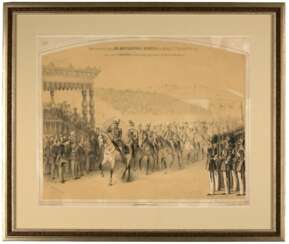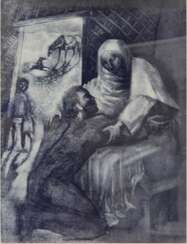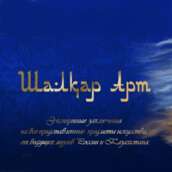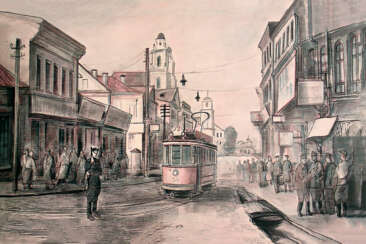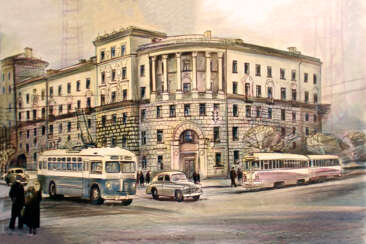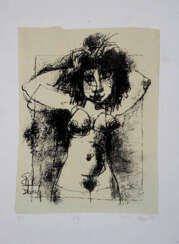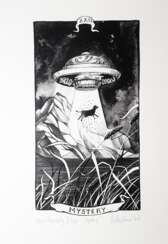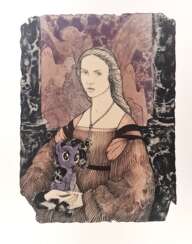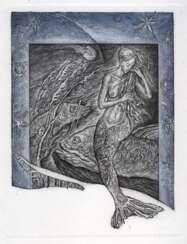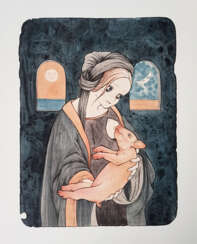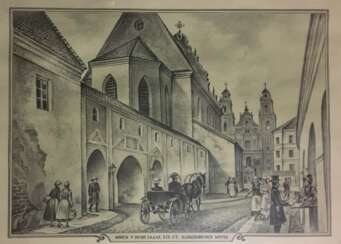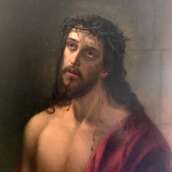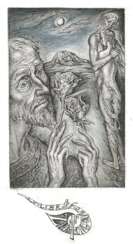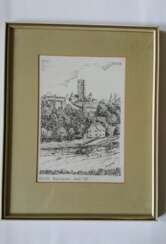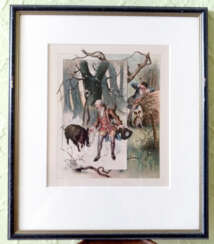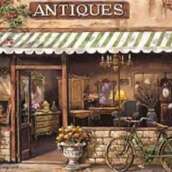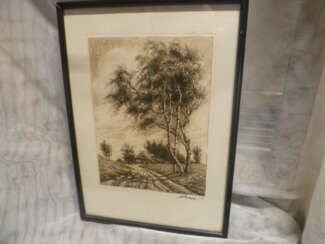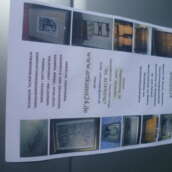23 Items by auctions and galleries:
графика, литография
Бык.
Bidzina Kavtaradze (b. 1962) 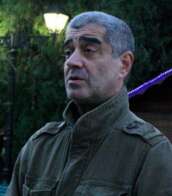 Shop Kavtaradze Bidzina
Shop Kavtaradze Bidzina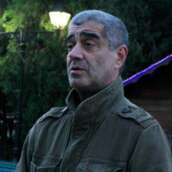

Bidzina Kavtaradze
29.01.1962
Georgia
Родился в 1962 г. в Тбилиси. Окончил Тбилисскую государственную академию художеств (графика, плакат). Главный художник издательства "Грузинский театр" при театральном обществе Грузии. Гл. художник-постановщик Тбилисского гос. драм.театра имени А.С. Грибоедова(1996-2002). Автор 52 театральных плакатов и 37 сценографии. Спектакли в Грузии в городах: Тбилиси, Батуми, Рустави, Чиатура. В России: в Таганроге, Ростове на Дону, Петрозаводске, Николаеве. Ныне руководитель мастерской креативной живописи в Тбилисской государственной академии художеств. В настоящее время работает в разных жанрах: графика, литография, книжная графика, смешанная техника, живопись, скульптура. Работы хранятся в частных коллекциях в Грузии, Франции, Швейцарии, США, России. Групповые выставки: в Тбилиси, Москве, Париже. Персональные выставки в галереях: "N Gallery", "Шарден", "Вернисаж", "Арси".

Artist shop
Kavtaradze Bidzina
Georgia
Number of products: 26
Ню.
Bidzina Kavtaradze (b. 1962)  Shop Kavtaradze Bidzina
Shop Kavtaradze Bidzina

Bidzina Kavtaradze
29.01.1962
Georgia
Родился в 1962 г. в Тбилиси. Окончил Тбилисскую государственную академию художеств (графика, плакат). Главный художник издательства "Грузинский театр" при театральном обществе Грузии. Гл. художник-постановщик Тбилисского гос. драм.театра имени А.С. Грибоедова(1996-2002). Автор 52 театральных плакатов и 37 сценографии. Спектакли в Грузии в городах: Тбилиси, Батуми, Рустави, Чиатура. В России: в Таганроге, Ростове на Дону, Петрозаводске, Николаеве. Ныне руководитель мастерской креативной живописи в Тбилисской государственной академии художеств. В настоящее время работает в разных жанрах: графика, литография, книжная графика, смешанная техника, живопись, скульптура. Работы хранятся в частных коллекциях в Грузии, Франции, Швейцарии, США, России. Групповые выставки: в Тбилиси, Москве, Париже. Персональные выставки в галереях: "N Gallery", "Шарден", "Вернисаж", "Арси".

Artist shop
Kavtaradze Bidzina
Georgia
Number of products: 26
Кабан.
Bidzina Kavtaradze (b. 1962)  Shop Kavtaradze Bidzina
Shop Kavtaradze Bidzina

Bidzina Kavtaradze
29.01.1962
Georgia
Родился в 1962 г. в Тбилиси. Окончил Тбилисскую государственную академию художеств (графика, плакат). Главный художник издательства "Грузинский театр" при театральном обществе Грузии. Гл. художник-постановщик Тбилисского гос. драм.театра имени А.С. Грибоедова(1996-2002). Автор 52 театральных плакатов и 37 сценографии. Спектакли в Грузии в городах: Тбилиси, Батуми, Рустави, Чиатура. В России: в Таганроге, Ростове на Дону, Петрозаводске, Николаеве. Ныне руководитель мастерской креативной живописи в Тбилисской государственной академии художеств. В настоящее время работает в разных жанрах: графика, литография, книжная графика, смешанная техника, живопись, скульптура. Работы хранятся в частных коллекциях в Грузии, Франции, Швейцарии, США, России. Групповые выставки: в Тбилиси, Москве, Париже. Персональные выставки в галереях: "N Gallery", "Шарден", "Вернисаж", "Арси".

Artist shop
Kavtaradze Bidzina
Georgia
Number of products: 26
Сосуд и раковина
Leonid Stroganov (b. 1979) 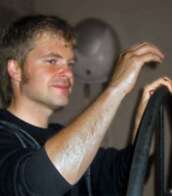 Shop Stroganov Leonid
Shop Stroganov Leonid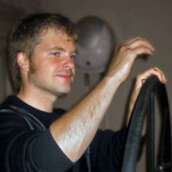

Leonid Stroganov
24.11.1979
Russia
Я родился в 1979 году в Ленинграде.В 1999 году закончил СПбХУ им Рериха,факультет живописи,а в 2002 году Институт Декоративно-Прикладного Искусства,факультет графики.Член Союза Художников России с 2002 года.В 2006 году прошел стажировку в Институте Тамаринд(США)Провел около 15 персональных выставок в музеях,выставочных залах и галереях России,Дании,Финляндии и Швейцарии.В жанре "Книга художника"создал книги " Царь Эдип" Софокла и "Эротические сонеты" Абрама Эфроса.Для идательства "Вита -Нова" выполнил иллюстрации к "Сонетам" Франческо Петрарки и Книге Пророка Исаии.
являюсь автором приблизительно 100 книжных знаков.Принимал участие в конгрессах международной федерации экслибриса(FISAE).Неоднократно становился лауреатом всероссийских имеждународных конкурсов в этой области.
Мои работы находятся в собраниях:Библиотеки Государственного Эрмитажа и его филиала-Выставочного центра "Эрмитаж-Выборг",Государственной публичной библиотеки им.М.Е.Салтыкова-щедрина,Всероссийского музея А.С.Пушкина,Литературно-мемориального музея-квартиры Ф.М.Достоевского,Сахалинского областного художественного музея,Государственного музея изобразительных искусств республики Татарстан,Ямало-Ненецкого окружного музейно-выставочного комплекса им И.С. Шемановского(Салехард),картинной галереи Вологодской области,музеев изобразительных искусств Старого Оскола,Орла,Екатеринбурга,Музея замка Мальборк (Польша),музея графики малых форм(Сент-Никлаас,Бельгия)Института Тамаринд (США),Музея печати в Шеньчжене(Китай),Музея искусств Фредериксхавна(Дания) и частных собраниях.

Artist shop
Stroganov Leonid
Russia
Number of products: 61
"Мистерия"
Sviatlana Petushkova (b. 1990)  Shop Petushkova Sviatlana
Shop Petushkova Sviatlana

Sviatlana Petushkova
11.07.1990
Byelorussia
Я художник график из Минска, куратор Белорусского Дома Графики и мастер печатник.
Я имею высшее художественное образование, регулярно участвую в выставках с 2006 года.
В основном я работаю в печатных графических техниках, таких как офорт, литография, шелкография, но иногда эксперементирую с живописью.
Мои работы концептуальны, в них я рассуждаю о реалиях современного общества, его нравах и заблуждениях, поднимаю актуальные проблемы современности.

Artist shop
Petushkova Sviatlana
Byelorussia
Number of products: 4
Автопортрет с единорогом
Sviatlana Petushkova (b. 1990)  Shop Petushkova Sviatlana
Shop Petushkova Sviatlana

Sviatlana Petushkova
11.07.1990
Byelorussia
Я художник график из Минска, куратор Белорусского Дома Графики и мастер печатник.
Я имею высшее художественное образование, регулярно участвую в выставках с 2006 года.
В основном я работаю в печатных графических техниках, таких как офорт, литография, шелкография, но иногда эксперементирую с живописью.
Мои работы концептуальны, в них я рассуждаю о реалиях современного общества, его нравах и заблуждениях, поднимаю актуальные проблемы современности.

Artist shop
Petushkova Sviatlana
Byelorussia
Number of products: 4
Русалка
Leonid Stroganov (b. 1979)  Shop Stroganov Leonid
Shop Stroganov Leonid

Leonid Stroganov
24.11.1979
Russia
Я родился в 1979 году в Ленинграде.В 1999 году закончил СПбХУ им Рериха,факультет живописи,а в 2002 году Институт Декоративно-Прикладного Искусства,факультет графики.Член Союза Художников России с 2002 года.В 2006 году прошел стажировку в Институте Тамаринд(США)Провел около 15 персональных выставок в музеях,выставочных залах и галереях России,Дании,Финляндии и Швейцарии.В жанре "Книга художника"создал книги " Царь Эдип" Софокла и "Эротические сонеты" Абрама Эфроса.Для идательства "Вита -Нова" выполнил иллюстрации к "Сонетам" Франческо Петрарки и Книге Пророка Исаии.
являюсь автором приблизительно 100 книжных знаков.Принимал участие в конгрессах международной федерации экслибриса(FISAE).Неоднократно становился лауреатом всероссийских имеждународных конкурсов в этой области.
Мои работы находятся в собраниях:Библиотеки Государственного Эрмитажа и его филиала-Выставочного центра "Эрмитаж-Выборг",Государственной публичной библиотеки им.М.Е.Салтыкова-щедрина,Всероссийского музея А.С.Пушкина,Литературно-мемориального музея-квартиры Ф.М.Достоевского,Сахалинского областного художественного музея,Государственного музея изобразительных искусств республики Татарстан,Ямало-Ненецкого окружного музейно-выставочного комплекса им И.С. Шемановского(Салехард),картинной галереи Вологодской области,музеев изобразительных искусств Старого Оскола,Орла,Екатеринбурга,Музея замка Мальборк (Польша),музея графики малых форм(Сент-Никлаас,Бельгия)Института Тамаринд (США),Музея печати в Шеньчжене(Китай),Музея искусств Фредериксхавна(Дания) и частных собраниях.

Artist shop
Stroganov Leonid
Russia
Number of products: 61
Мадонна
Sviatlana Petushkova (b. 1990)  Shop Petushkova Sviatlana
Shop Petushkova Sviatlana

Sviatlana Petushkova
11.07.1990
Byelorussia
Я художник график из Минска, куратор Белорусского Дома Графики и мастер печатник.
Я имею высшее художественное образование, регулярно участвую в выставках с 2006 года.
В основном я работаю в печатных графических техниках, таких как офорт, литография, шелкография, но иногда эксперементирую с живописью.
Мои работы концептуальны, в них я рассуждаю о реалиях современного общества, его нравах и заблуждениях, поднимаю актуальные проблемы современности.

Artist shop
Petushkova Sviatlana
Byelorussia
Number of products: 4
Lydia Tremmery (b. 1946) 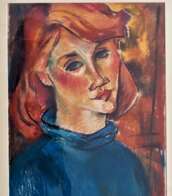 Shop Tremmery Lydia
Shop Tremmery Lydia

Lydia Tremmery
27.02.1946
Ukraine
Лидия Альбертовна Треммери — украинская художница бельгийского происхождения. Родилась в г.Гент (Бельгия), в Украину переехала в 1965 г. Училась в Королевской Академии изящных искусств г.Гента, затем в 1973 г. - окончила Киевский художественный институт. Пастелист и литографист, художник-иллюстратор детскиг книг в издательстве "Веселка". Член Национального союза художников Украины с 1980 г. Почётный гражданин Королевства Бельгия.
Выставочная деятельность:
1973 год — Республиканская выставка «Этюды» (Рига)
1975 год — выставка «Женский портрет»
1976 год — Республиканская выставка книги
1976 год — выставка «Эстамп»
1977 год — Республиканская выставка молодых художников
1978 год — женская выставка СХУ
1980 год — женская выставка СХУ
1980 год — Республиканская выставка «Эстамп»
1980 год — Республиканская выставка молодых художников
1982 год — Всесоюзная выставка «Эстамп»
1982 год — Республиканская выставка «Эстамп»
1983 год — групповая творческая выставка СХУ
Все работы представлены на персональном сайте Лидии Треммери https://tremmeri2010.wixsite.com/lydia-tremmery
https://uk.wikipedia.org/wiki/%D0%A2%D1%80%D0%B5%D0%BC%D0%BC%D0%B5%D1%80%D1%96_%D0%9B%D1%96%D0%B4%D1%96%D1%8F_%D0%90%D0%BB%D1%8C%D0%B1%D0%B5%D1%80%D1%82%D1%96%D0%B2%D0%BD%D0%B0

Artist shop
Tremmery Lydia
Ukraine
Number of products: 3
Leonid Stroganov (b. 1979)  Shop Stroganov Leonid
Shop Stroganov Leonid

Leonid Stroganov
24.11.1979
Russia
Я родился в 1979 году в Ленинграде.В 1999 году закончил СПбХУ им Рериха,факультет живописи,а в 2002 году Институт Декоративно-Прикладного Искусства,факультет графики.Член Союза Художников России с 2002 года.В 2006 году прошел стажировку в Институте Тамаринд(США)Провел около 15 персональных выставок в музеях,выставочных залах и галереях России,Дании,Финляндии и Швейцарии.В жанре "Книга художника"создал книги " Царь Эдип" Софокла и "Эротические сонеты" Абрама Эфроса.Для идательства "Вита -Нова" выполнил иллюстрации к "Сонетам" Франческо Петрарки и Книге Пророка Исаии.
являюсь автором приблизительно 100 книжных знаков.Принимал участие в конгрессах международной федерации экслибриса(FISAE).Неоднократно становился лауреатом всероссийских имеждународных конкурсов в этой области.
Мои работы находятся в собраниях:Библиотеки Государственного Эрмитажа и его филиала-Выставочного центра "Эрмитаж-Выборг",Государственной публичной библиотеки им.М.Е.Салтыкова-щедрина,Всероссийского музея А.С.Пушкина,Литературно-мемориального музея-квартиры Ф.М.Достоевского,Сахалинского областного художественного музея,Государственного музея изобразительных искусств республики Татарстан,Ямало-Ненецкого окружного музейно-выставочного комплекса им И.С. Шемановского(Салехард),картинной галереи Вологодской области,музеев изобразительных искусств Старого Оскола,Орла,Екатеринбурга,Музея замка Мальборк (Польша),музея графики малых форм(Сент-Никлаас,Бельгия)Института Тамаринд (США),Музея печати в Шеньчжене(Китай),Музея искусств Фредериксхавна(Дания) и частных собраниях.

Artist shop
Stroganov Leonid
Russia
Number of products: 61
To Sonnets of Petrarch
Leonid Stroganov (b. 1979)  Shop Stroganov Leonid
Shop Stroganov Leonid

Leonid Stroganov
24.11.1979
Russia
Я родился в 1979 году в Ленинграде.В 1999 году закончил СПбХУ им Рериха,факультет живописи,а в 2002 году Институт Декоративно-Прикладного Искусства,факультет графики.Член Союза Художников России с 2002 года.В 2006 году прошел стажировку в Институте Тамаринд(США)Провел около 15 персональных выставок в музеях,выставочных залах и галереях России,Дании,Финляндии и Швейцарии.В жанре "Книга художника"создал книги " Царь Эдип" Софокла и "Эротические сонеты" Абрама Эфроса.Для идательства "Вита -Нова" выполнил иллюстрации к "Сонетам" Франческо Петрарки и Книге Пророка Исаии.
являюсь автором приблизительно 100 книжных знаков.Принимал участие в конгрессах международной федерации экслибриса(FISAE).Неоднократно становился лауреатом всероссийских имеждународных конкурсов в этой области.
Мои работы находятся в собраниях:Библиотеки Государственного Эрмитажа и его филиала-Выставочного центра "Эрмитаж-Выборг",Государственной публичной библиотеки им.М.Е.Салтыкова-щедрина,Всероссийского музея А.С.Пушкина,Литературно-мемориального музея-квартиры Ф.М.Достоевского,Сахалинского областного художественного музея,Государственного музея изобразительных искусств республики Татарстан,Ямало-Ненецкого окружного музейно-выставочного комплекса им И.С. Шемановского(Салехард),картинной галереи Вологодской области,музеев изобразительных искусств Старого Оскола,Орла,Екатеринбурга,Музея замка Мальборк (Польша),музея графики малых форм(Сент-Никлаас,Бельгия)Института Тамаринд (США),Музея печати в Шеньчжене(Китай),Музея искусств Фредериксхавна(Дания) и частных собраниях.

Artist shop
Stroganov Leonid
Russia
Number of products: 61
Flowers and amphora.
Leonid Stroganov (b. 1979)  Shop Stroganov Leonid
Shop Stroganov Leonid

Leonid Stroganov
24.11.1979
Russia
Я родился в 1979 году в Ленинграде.В 1999 году закончил СПбХУ им Рериха,факультет живописи,а в 2002 году Институт Декоративно-Прикладного Искусства,факультет графики.Член Союза Художников России с 2002 года.В 2006 году прошел стажировку в Институте Тамаринд(США)Провел около 15 персональных выставок в музеях,выставочных залах и галереях России,Дании,Финляндии и Швейцарии.В жанре "Книга художника"создал книги " Царь Эдип" Софокла и "Эротические сонеты" Абрама Эфроса.Для идательства "Вита -Нова" выполнил иллюстрации к "Сонетам" Франческо Петрарки и Книге Пророка Исаии.
являюсь автором приблизительно 100 книжных знаков.Принимал участие в конгрессах международной федерации экслибриса(FISAE).Неоднократно становился лауреатом всероссийских имеждународных конкурсов в этой области.
Мои работы находятся в собраниях:Библиотеки Государственного Эрмитажа и его филиала-Выставочного центра "Эрмитаж-Выборг",Государственной публичной библиотеки им.М.Е.Салтыкова-щедрина,Всероссийского музея А.С.Пушкина,Литературно-мемориального музея-квартиры Ф.М.Достоевского,Сахалинского областного художественного музея,Государственного музея изобразительных искусств республики Татарстан,Ямало-Ненецкого окружного музейно-выставочного комплекса им И.С. Шемановского(Салехард),картинной галереи Вологодской области,музеев изобразительных искусств Старого Оскола,Орла,Екатеринбурга,Музея замка Мальборк (Польша),музея графики малых форм(Сент-Никлаас,Бельгия)Института Тамаринд (США),Музея печати в Шеньчжене(Китай),Музея искусств Фредериксхавна(Дания) и частных собраниях.

Artist shop
Stroganov Leonid
Russia
Number of products: 61
